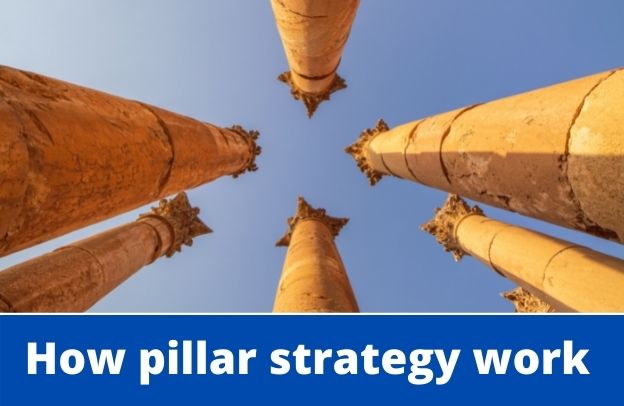Brand Building, Using Content Pillar Strategy

Do you want to learn about the ultimate strategy for content creation? Do you want to stand out from the noise? Listen, we have gone beyond just creating content. Also because there is no lack of content out there. So, now is about the strategy that can work for your brand-building exercise and business success.Claim Your Content Creation Checklist.
This is a continuation of our series on Brand building through content creation. If you are new here, see the first publication in the series: Brand Building With Content Creation – The Right Way.
As far back as 2019, 3 years ago, Gary Vaynerchuk (Gary vee) said on his Twitter page and I quote: “Mastering content strategy, creation, and distribution for your brand on social media is a difficult and long process.” You know what? That is still freaking true today in 2022.
Now, here are a few things to know about pillar content strategy or staple content as some will prefer to call it:
- Length matter – take the time it requires to cover all aspects of your broad topic,
- Understand the linking process – like a book with the classic table of content, provide links (interlinks among the pillar pages) for people to easily expand their knowledge of your topic,
- Helpful for your business and brand – pillar content strategy is extremely beneficial to your brands. You are taking the time to create authority in your industry and there is no way it will not work for you if you do it well.
- It’s SEO friendly – pillar content strategy works because the search engine algorithm is switching from a keyword-based to a topic-focused. That is a huge advantage if you have enough valuable content to feed the machine. Think about that.
Now, let’s break down the argument of pillar content strategy even more.
What is a Content Pillar Strategy?
A pillar content strategy is an effective way of creating sustainable link-building campaigns by offering high-value content in large quantities. Your pillar page features all the information you would typically cram into multiple white papers or eBooks on one singular page or blog post.
The purpose of this strategy is to focus on a particular topic that you are trying to rank for in the SERPs with the ultimate goal of securing higher rankings with less time and effort.
The pillar content strategy for your website is very thorough and allows you to be successful with two types of content.
One type is to create informative answers about the topic, such as “What is content creation?” and the other type is to effectively answer the user’s questions like, “how to create content?
How Does Pillar Content Boost SEO?
Search engines are getting better and better at responding to conversational queries. According to a recent report from HubSpot, search engines have been able to learn how to respond in more natural ways.
This is because the search engines now understand the grammatical structure of language and topic relevance, and are therefore able to determine the intent of a question. So, it’s no longer just about the keywords, but the topic you want to understand by your search queries.
“Your pillar page will start ranking in search for the particular topic you’re focusing on, which will help other blog posts rank as well — the expression ‘the rising tide lifts all ships’ applies here.”
“Instead of writing a blog post after blog post focusing on different keyword variations of the same topic,” continue the HubSpot article, How to Create a Pillar Page, “you’ll have an organized site infrastructure made up of one pillar page and specific, in-depth blog posts that address content gaps about the topics.”
Now, the main way in which pillar content helps to boost SEO is the increased visibility of a business’s website. This can increase conversions, number of visitors and lead to new customers. Pillar content can also help with:
- Brand awareness,
- Customer retention,
- Increase in backlinks,
- Lead to new customers
- And increase conversions
Pillar content is an important part of website design. It is a piece of content that helps build the foundation and establish trust with potential customers. It can be created in the form of blog posts, social media posts, articles, emails, and much more.
For a more practical example, consider our series of articles, which this particle post is part of.
How To Create Pillar Content
Pillar content is a topic that is critical to your business’ success, but not all of your customers might be interested in it. If you want to optimize the content on your site to improve conversions, then you need to create pillar content that resonates with your target audience. That is very important.
To create pillar content, you need to narrow it down to one topic you want to rank for on Google and develop your content around that topic.
Creating pillars content is similar to building house structures as they both are composed of a single central idea with many supporting ideas layered around it.
After you have created the central pillar content, you will need a few more supporting materials – related blog posts, for example, to help users find more information about the topic without ever leaving your website.
This is what makes a pillar content strategy an important part of website development.
In most cases, a pillar content strategy is a marketing strategy that helps companies focus their efforts on a specific area of their business.
The chosen pillar can then provide the foundation for other areas of the business like SEO. This gives your company a clear goal and purpose.
Subtopic keywords focus on a specific question that may have been raised on your pillar page but now selected for better clarification. In the typical content design of a pillar, the subtopic should include a link back to your pillar page.
Developing pillar content is an effective solution for getting your content in front of people that are looking for it. It is a very simple process and you can use it to make your content more discoverable in different ways.
How does the content pillar strategy work?
As I have said before, a pillar is a supporting structure on which other structures are built to rest. Looking at it from that perspective, to create a successful content strategy, your content pillars must be strong enough to support other elements of the building blocks.
Now, a user lands on one of your pages and begins to consume information, and soon realizes that several other aspects of that topic have been dealt with in detail, unlike some random articles the user may have seen elsewhere.
“This is a gold mine”, the user exclaims and continues to consult your treatment of the topics, navigating through your internal linking in between the posts. This is the power of the content pillar strategy at work.
Even the God of google now suddenly likes you, the bounce rate is suddenly low because the user remains on your site.
Now, the higher Customer retention, the upsurge in backlinks, and the increase in conversions we talked about at the beginning of this article now come to make sense to you. Yes, it all works.
The question now is “will you apply this in your business strategy”.
Key takeaways from Content Pillar Strategy For Your Brand Building
A pillar content strategy is a way of creating content that has resounding value in your industry. It is a way to create content that can provide value for your audience and also provide an advantage over the competition.
If you look around today, you will see that the most successful brands are investing a lot of money into content marketing.
Sure, generating a lot of quality content can take a long time and effort, but it can help your brand to stand out. Starting today, understand the true benefits of pillar content strategy for your brand building and business.
If you find any value in this post, share also with your friends who might need it. Claim Your Content Creation Checklist.









2 Comments